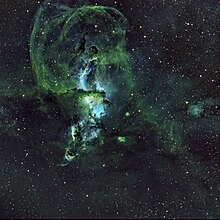
NGC 3576 is a bright emission nebula in the Sagittarius arm of the galaxy a few thousand light-years away from the Eta Carinae nebula. It is also approximately 100 light years across and 9000 light-years away from Earth.[3] It was discovered by John Frederick William Herschel on 16 March 1834.[4] This nebula has received six different classification numbers. Currently, astronomers call the entire nebula NGC 3576. A popular nickname is "The Statue of Liberty Nebula" because of the distinctive shape in the middle of the nebula. The name was first suggested in 2009 by Dr. Steve Mazlin, a member of Star Shadows Remote Observatory (SSRO).[5] Within the nebula, episodes of star formation are thought to contribute to the complex and suggestive shapes. Powerful winds from the nebula's embedded, young, massive stars shape the looping filaments.[6]

References
- ^ a b "NASA/IPAC Extragalactic Database". Retrieved 2007-04-27.
- ^ "Atlas of the Universe". Archived from the original on 2015-07-18. Retrieved 2007-04-27.
- ^ "NGC 3576, the Statue of Liberty Nebula". 27 June 2012.
- ^ "Category:NGC 3576 - Wikimedia Commons".
- ^ "Star Shadows Remote Observatory Gallery".
- ^ "APOD: 2008 March 26 - The NGC 3576 Nebula". apod.nasa.gov. Retrieved 2021-02-11.
External links
 Media related to NGC 3576 at Wikimedia Commons
Media related to NGC 3576 at Wikimedia Commons- Photo of the "Statue of Liberty"









You must be logged in to post a comment.